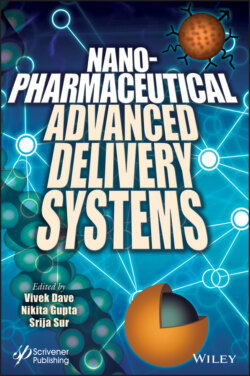Читать книгу Nanopharmaceutical Advanced Delivery Systems - Группа авторов - Страница 16
1.2 An Overview on Nanocarriers
ОглавлениеIn the early 1990s, solid polymers in nanoparticles consisting of non-biodegradable and biodegradable polymers having size from 10 to 1000 nm with site-specific delivery feature and regulated drug release were developed. However, the major problem encountered was the higher cytotoxicity associated with these polymers [9-11]. Therefore, lipid-derived carriers emerged as a keystone for novel formulations because of its low cytotoxicity.
In the past two decades, the development of lipid-based drug carriers has received greater attention. Lipid nanoparticles offer several potential uses in the fields of drugs delivery, clinical medicine, research, and other varied sciences. Due to their unusual dimensional dependency, lipid nanoparticles provide the opportunity to develop new therapeutics. A new prototype in drug delivery for secondary and tertiary targeting can be made possible by incorporating the drug into these nanocarriers [12].
The first liposomes were introduced by Dior in 1986 to the cosmetic market. After several years, liposomes in the form of pharmaceutical products appeared in the market. As a novel carrier, liposomes were not only technically advanced but also have gained wide public interest. There are several other concepts of formulation; for example, microemulsions, nanoemulsions, and solid particles (such as microsponge) were also explored in the last two decades. Nevertheless, these nanocarriers have not been found in wide applications and have not gained any attention like liposomes.
SLNs have certain benefits in contrast to liposomes and emulsion, e.g., protecting the active compounds from chemical oxidation and offering greater versatility in amplifying compound release [12, 13]. Furthermore, lipid nanoparticles made of solid lipid and liquid lipid were explored by different research groups, which were used on a variety of routes such as parenteral, oral, dermal, ocular, or rectal and were thoroughly characterized [14, 15]. Nowadays, modified SLNs were known as nanostructured lipid carriers (NLCs) and nanoparticles lipid drug conjugates (LDCs) [13, 16, 17]. These carrier systems were able to resolve the issues observed with conventional SLNs.
A lipid nanocarrier system provides the drug with smaller droplet sizes in solubilized form offering a large surface area, which increases the activity of pancreatic lipases for the hydrolysis of triglycerides, and this will enable the faster release of the drug. Neoral® (cyclosporin A) is a commercial product that is an excellent example of the utilization of these systems [18]. This carrier system has another advantage in that it can be used for clinical purposes because organic solvents can be avoided during the preparation process. A further advantage is that it is easy and cost-effective to produce.
